If you’ve been lurking around the web for some time now, chances are you’ve probably come across the term “NFT” and wondered what in the world it is. Non-fungible tokens, or NFTs, are unique digital assets that one can trade and own. Examples include digital art, video game items, avatars, and collectibles.
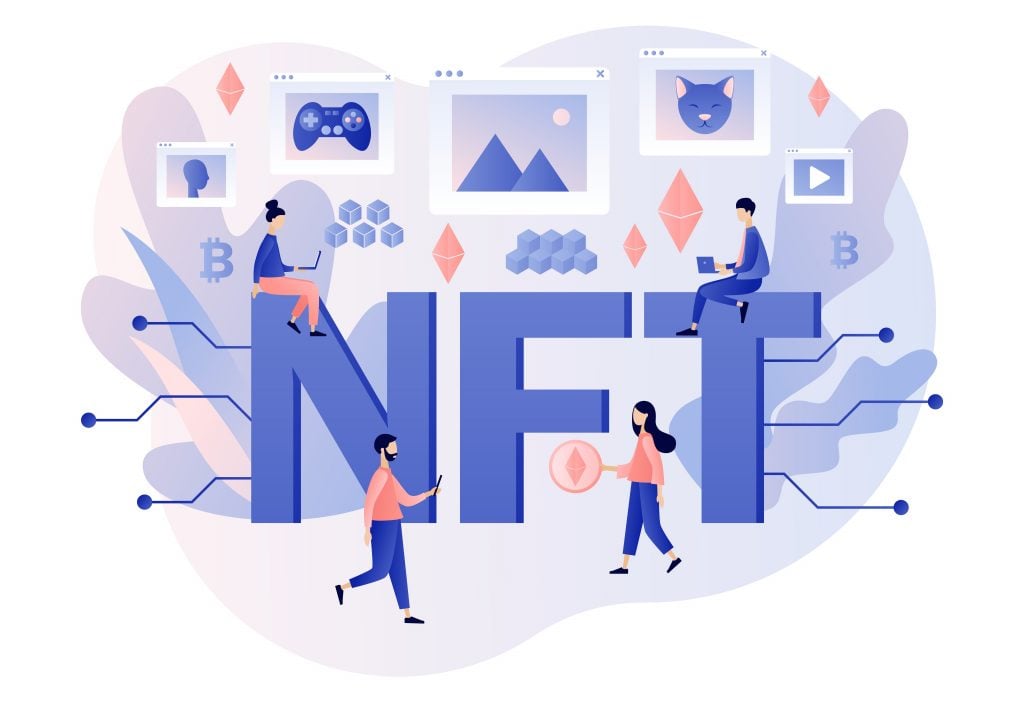
The term “non-fungible,” simply put, means that NFTs are not interchangeable. Traditional currency is fungible because a dollar can be exchanged for another dollar since they have the exact same value. It’s a different story with art. Two Van Gogh paintings would be valued and priced differently even if they are both by Van Gogh. So, for instance, you can’t do a fair exchange of The Starry Night with Sunflowers.
Each NFT is unique, and all are managed on a blockchain similar to how cryptocurrencies operate. In fact, many NFTs are traded using cryptocurrencies—Ethereum, in particular. While digital art and collectibles are some of the more popular forms of NFTs, few people realize that website domains can also be tokenized and traded.
NFT Domains:
But First, How Do Domain Names Work?
Before we dive into NFT domains, let’s backtrack a bit and take a look at how domain names are traditionally obtained. Domain names are the online addresses of websites. This is what you enter in a browser in order to go to a specific website (e.g., influencermarketinghub.com).
In reality, the address of a website is a string of numeric characters called the IP (Internet Protocol) address. The Domain Name System or DNS was created to make it easier for end-users to remember internet addresses. Think of IP addresses as map coordinates that pinpoint the exact location of a place and the domain name as the easy-to-remember alphanumeric address (123 Main Street).
DNS servers function as phone books that translate domain names to IP addresses so that when you input a website name into a browser, the computer knows just what specific data you are requesting and sends back the correct data—in this case, the website you want to visit.
These domain names are managed by an American nonprofit organization called the Internet Corporation for Assigned Names and Numbers (ICANN). To use a domain name for your website, you’ll need to register and purchase it from a domain name registrar, such as GoDaddy or Google Domains.
However, in this case, “purchasing” your domain name does not mean that you actually own it. You are simply buying the rights to use “yourcompanyname.com” on the web. It is more similar to a rental or lease of the name, not a sale. This is why domain registrars charge annual fees for the use of domain names and stipulate the length of time when you can use them. Once a user fails to pay or the contract expires, the domain name goes back on the market and can be used by anyone who registers it first. In fact, unscrupulous companies and cybersquatters exploit the system by monitoring domain names that are about to expire, then purchasing them immediately once they do. They then sell the name back to the original owner for a much higher price or put it on the market themselves to sell to the highest bidder.
Why the Need for Decentralized Domains?
For the average Internet user, the many complex layers that go into ensuring that websites and online activities run smoothly are largely invisible. Because there are hundreds of millions of registered domain names, not to mention the other systems and processes to keep the Web 2.0 Internet functioning properly, ICANN has a ton of work to do. The Internet Assigned Numbers Authority (IANA) is a department within ICANN that manages the domain registries.
Domain registries are big, private companies that handle and manage domain names and their records. These are different from domain name registrars who handle commercial sales of domain names and can be considered the middlemen. GoDaddy is a domain name registrar. It sells domain names to end users, registers paid domain names, and also forks over a fee to the domain registry.
If this all sounds a bit unwieldy, then you might begin to understand why developers are pushing for a more decentralized system. Even if DNS is already mainly decentralized, the context within which it operates is still largely centralized, with domain registries at the center of it all.
Okay, So How Are NFT Domains Different?
If you’ve read up on NFTs, you’ll know that they grant ownership of the corresponding digital asset to the buyer. So other people may view a piece of artwork online, but only the owner of the NFT has the original copy and the certification of authenticity. In the same way, purchasing an NFT domain gives you ownership of the domain name, instead of merely renting it out for a period of time.
NFT domains decentralize the domain name registration system. As outlined above, traditional domain names, also known as Web 2.0 domains, are managed under one company with many additional layers of management in between. This is the Internet that most of us are familiar with and accustomed to. The Web 2.0 Internet is more centralized, run and managed by private companies like Google and Meta that offer web services in exchange for personal data.
Web 3.0 domains, on the other hand, are decentralized, with ownership and control of the domain name going to whoever purchases the NFT. Many in the blockchain industry are even beginning to call Web 3.0 the future of the Internet as blockchain technology gains momentum.
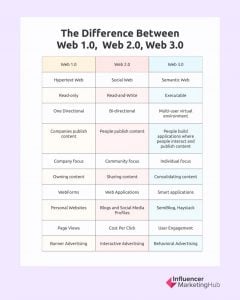
What Can NFT Domains Do?
If you are already familiar with cryptocurrencies, you know that you need to have a compatible wallet in which to store your cryptocurrency tokens. NFT domains have more functions than simply being a website address. They can also be used as cryptocurrency wallets, and because they are NFTs, you can buy, sell, and hold them as if they were ordinary NFTs.
As a website, you can go ahead and type in your NFT domain name in a compatible browser, and in the same way as Web 2.0 domains like .com and .org, the NFT domain will show users the website content that you put there. As a cryptocurrency wallet, you can use that same domain name to send and receive compatible cryptocurrencies.
Blockchain-based domain names have top-level domains (TLDs) that are different from Web 2.0 TLDs, which are all under the management and jurisdiction of ICANN. Since NFTs are decentralized and separate from Web 2.0, NFT domain names offer different TLDs:
- .nft
- .crypto
- .bitcoin
- .x
- .blockchain
Among these popular extensions, domains with .nft and .crypto tend to be pricier than others.
Pros and Cons of NFT Domains
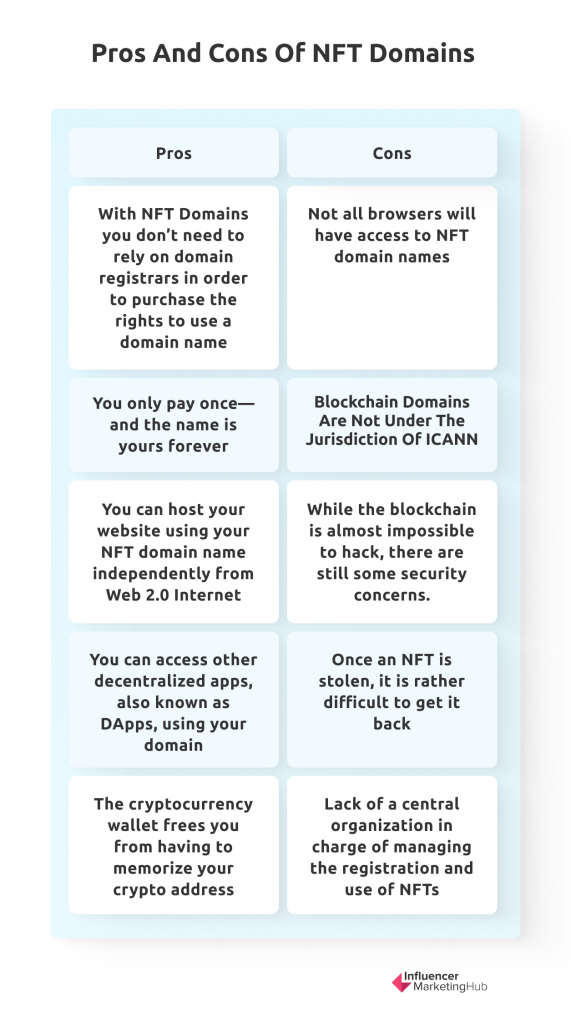
NFTs are all about cementing ownership and authenticity of a unique digital asset. For domain names, this means that you don’t need to rely on domain registrars in order to purchase the rights to use a domain name. The many layers of the Web 2.0 hierarchy mean that these organizations can still exert control over what you do with the domain name and have the power to censor you. In addition, these companies charge fees—fees that you, the end user, will have to shoulder.
Which brings us to another advantage of NFT domain names: you only pay once—just the initial sale price. It’s not a rental fee where you receive a billing statement every year to continue using the domain name. Once you register and pay the fee, the name is yours forever (or until you decide to sell it to another person). The threat of cybersquatters swooping in to purchase your domain name upon its expiration will no longer exist in NFT domains.
You can also host your website using your NFT domain name independently from Web 2.0 Internet. Plus, you can access other decentralized apps, also known as DApps, using your domain. As a cryptocurrency wallet, it also frees you from having to memorize your crypto address, thereby decreasing the risk of mistyping it and sending valuable cryptocurrency to another wallet.
On the other hand, because NFT domain names are still in their infancy stage and somewhat experimental, not all browsers will have access to them. Many might need plugins to be able to access it. Blockchain domains are not under the jurisdiction of ICANN, so there’s no significant motive for mainstream browsers to support Web 3.0 domain names. Some browsers, like Brave, can support NFT domains; it’s just a matter of time before more browsers follow suit.
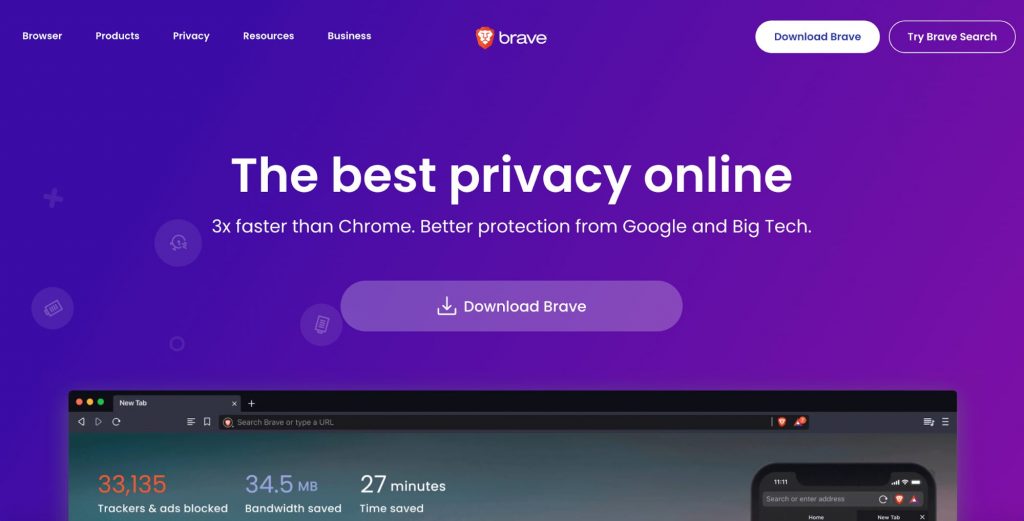
Source: brave.com
Additionally, while the blockchain is immutable and almost impossible to hack, there are still some security concerns. Foremost among these are bugs that can still, on occasion, cause some damage to NFT marketplaces that affect buyers and users. And unfortunately, once an NFT is stolen or otherwise gone, it is rather difficult to get it back. To strengthen security, you’ll need additional safeguards to protect your digital assets.
Finally, the lack of a central organization in charge of managing the registration and use of NFTs might pose a problem when disputes or conflicts arise. In the case of traditional domain names, the ICANN can step in and resolve any disputes. For NFTs, if a brand finds out that someone else has already purchased an NFT domain with their brand name, there will be no official third party to manage the dispute.
How Do I Purchase an NFT Domain Name?
Buying an NFT domain is more similar to purchasing other NFTs than buying and registering a traditional Web 2.0 domain. Blockchain domain names can be purchased and registered via NFT marketplaces. Most NFT domain names are traded using cryptocurrencies, but there are providers that accept fiat currency. Registering an NFT domain name is easier than you think, especially if you’ve already traded NFTs before.
1. Look for a reputable and trusted NFT domain marketplace. Leading sellers include Unstoppable Domains and Ethereum Name Service. You can also check out popular NFT marketplaces like OpenSea and Rarible for NFT domains that are up for resale by the owners.
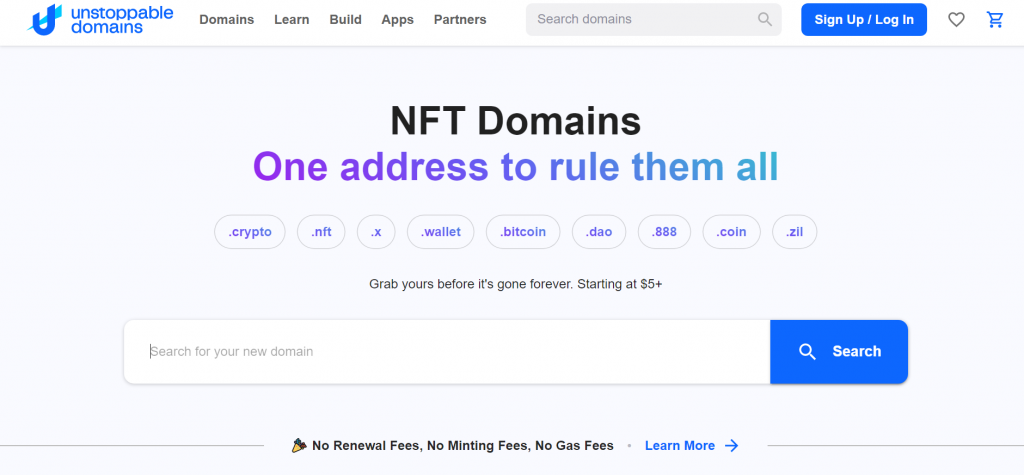
Source: unstoppabledomains.com
2. Type in your preferred domain name, then check from the selection of extensions available (.nft, .crypto, .bitcoin, etc.). Different TLDs will have different prices.
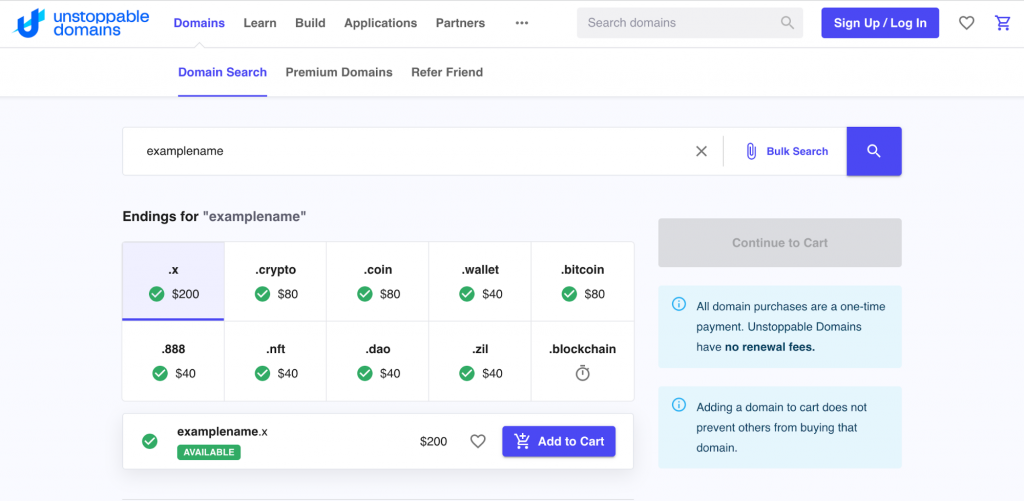
Source: unstoppabledomains.com
3. Pay the corresponding fee for your chosen name. Depending on the marketplace, there could be a few options for payment. You can choose to pay with cryptocurrency, credit card, and even PayPal.
4. The final step is “minting” the domain. This is just the process of claiming your domain; the blockchain will recognize that you own the domain name. After minting, you are now the certified owner of your domain name. Not only do you have an NFT you can store or sell to others, but you also have a website address and a cryptocurrency wallet. As it is a nonfungible token, be sure to store your domain name in a wallet.
The Future of NFT Domains and Web 3.0
As of today, Web 3.0 is still on the periphery of most Internet users. Web 2.0 is thriving, and because of the billion-dollar industry that is the Internet, organizations and companies that profit from it are not exactly eager to decentralize everything.
The good news is that our knowledge of blockchain technology is expanding, with developers continuously researching ways of making the Internet a better, more secure space.
Currently, the limitations of Web 3.0 can be attributed to the fact that it is a new version of the Internet we are all accustomed to. Being in the early stages, it is only natural for issues to arise as developers continue to work on them. Some of these issues include accessibility (as we’ve mentioned earlier, NFT domains are more difficult to access from most browsers), cost, scalability, and user experience. For casual Internet surfers, the extra steps, plugins, and knowledge required to run Web 3.0 apps and software may not be worth it. However, this can still change in the future as developers work on making decentralization more mainstream and user-friendly.
As technologies like machine learning and artificial intelligence, which are important components of Web 3.0’s smart applications, continue to advance, we might soon be able to experience a more mainstream version of Web 3.0, cryptocurrencies, and NFTs. The possibilities for a more decentralized Internet are just within our reach.


